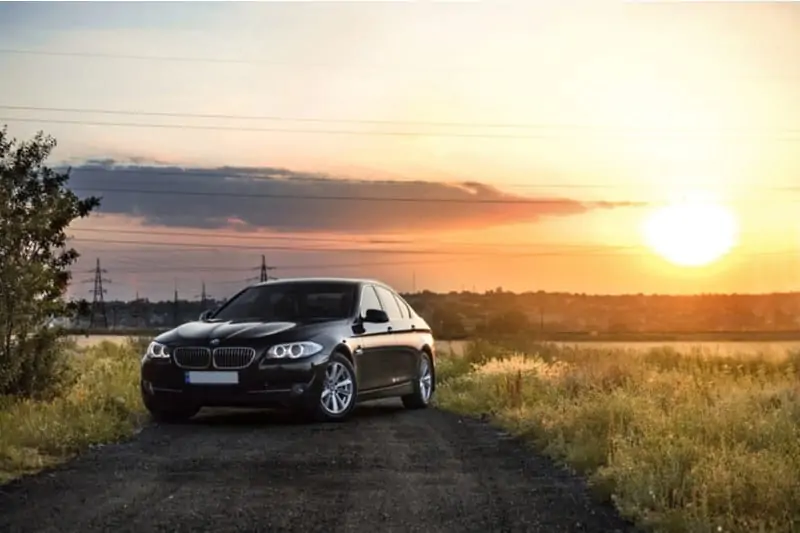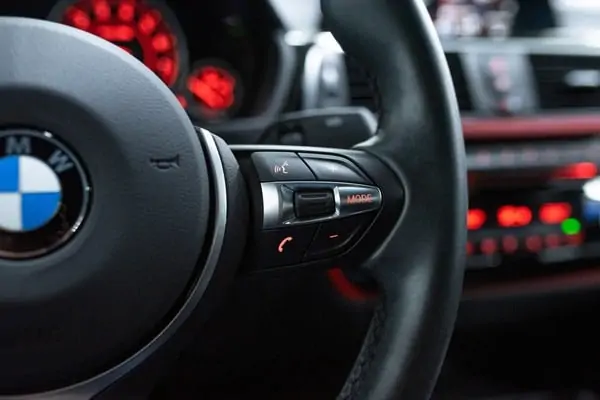The 411 on the BMW Series 5
Pin-Pointing Best Year for BMW 5 Series
As one of BMW’s best-selling models, the Series 5 is a powerful driving machine that truly does offer the “ultimate driving experience.” If you’re shopping the market for a new or used vehicle, BMW has a strong reputation of delivering first-rate cars, sports utility vehicles and motorcycles. The Series 5 model has been around for nearly 30 years and in the last decade, nearly half a million Series 5 units have been sold in the U.S. alone, making it a great choice for those specifically looking for a pre-owned one. Let’s get the 411 on the BMW Series 5 and answer a popular question, googled consistently: What’s the best year for the BMW Series 5? Let’s talk Bimmers.
If you are considering buying a used car that has under 140,000 miles and is a 2012 model or newer, get a free quote for one of our "extended car warranty solutions".
100% Online, 9 Coverage Options and No Robocalls!
A Long and Interesting History
BMW is a German automaker, primarily known now for producing luxury vehicles and motorcycles. Its history is long and interesting and one that didn’t just didn’t include producing automobiles at first.
The company was officially formed in 1916 under the german name Bayerische Flugzeugwerke AG and later renamed Bayerische Motoren Werke which translates into Bavarian Motor Works or BMW. BMW, however, dates back to 1913 when the original company used the BMW name to produce aircraft engines during WWI. BMW manufactured its first motorcycle seven years later in 1923 and officially became an automobile manufacturer more than a decade later in 1928.
Fast forward to 1962 when BMW introduced its first BMW New Class sedan launching its brand and reputation as one of the leading automakers. A decade later in 1972, BMW introduced its BMW Series 5. Soon after and throughout the 1970s, BMW continued to introduce other sedan series. The popular Series 3 was the first in a chain of sedan launches for BMW after the Series 5. Series 3 debuted in 1975, followed by Series 6 (1976) and Series 7 (1978).
Besides launching four sedan series, the ‘70s are an important decade in BMW’s history because that is when the automaker’s vehicles were so popular that they received a nickname – The Bimmer. During the 1970s, BMW was experiencing a boom in its popularity, specifically in the U.S. Americans began referring to BMW cars as “beamers,” but “beamer” was a term that was specifically used in the U.K. to refer to the BMW motorcycles. Shortly after this clarification, the term “bimmer” came about to refer to the BMW cars and has since then been the preferred nickname for car fans around the world. So, if you are talking about Beamers you’re talking motorcycles. Bimmer is the preferred nickname that references the BMW cars and is now mainstream.
A Model for Every Kind of Driver
BMW has a large catalog of vehicles to include sedans, wagons, hatchbacks, sports cars, SUVs and even hybrid electric cars. The brand is synonymous with luxury and appeals to a wide array of consumers with a different vehicle type for each. Current BMW Models include:
X1, X2, X3, X4, X5, X6, X7 – If you can’t decide between a sedan or a truck, BMW has you covered. The X models are BMW’s version of the sports utility vehicle or crossover. In the world of BMW, they are referred to and marketed as SAVs – Sports Activity Vehicles.
Series 2, 3, 4, 5, 7, 8 – If you’re looking for a sedan, BMW has six series to choose from, featuring 2-door coupes and 4-door classic sedans. Series 2, 3 and 4 are the sportier of the bunch and feature a more compact and sportier look. Series 5, 7 and 8 are the larger sedans, featured as executive and luxury sedans. Some coupes are offered within the S8.
Z4 – If you have a need for speed and like a smaller, sportier car for your drives, BMW’s roadster may be the right fit. It only comes in a 2-seater with no back seat.
The i3, i8 – Eco-friendly and environmentally conscious consumers may like the “i” series which are BMW’s hybrid electric car.
M – The “M” stands for motorsport. They were first created for BMW’s racing program, but they have evolved and are now a standard offering in the BMW line-up, offering the motorsport enhanced engines, transmission, suspension and interior trim.
The 2020 BMW Series 5
Specifically focused on the Series 5, these larger executive sedans offer a comfortable and luxurious ride. There’s a reason why the automaker’s slogan is: The Ultimate Driving Machine. The Series 5 boasts lots of standard features, including a roomy interior with plenty of head and legroom, and one of the largest trunks made even bigger thanks to the split-folding standard rear seats. It offers comfortable front and back seats that are both spacious and supportive. Other standard features include dual-zone automatic climate control, a moonroof and push-button start. The model boasts a user-friendly entertainment center that features a 10.25-inch touch screen, Apple CarPlay, two USB ports, Bluetooth capabilities, a 12-speaker stereo, HD radio and navigation. Standard driver-assist features include cruise control, a rearview camera, front and back parking sensors, pedestrian detection, auto braking, blind spot monitoring and much more. The list of standard features in the BMW Series 5 seems to be endless. A Series 5 model, brand new, will range in price from $53,900 to $61,750, depending on the model. BMW offers two core models, the 530i and 540i, both featuring an all-wheel drive option. Let’s explore the latest Series 5 models.
530i Sedan
It features a 2.0-liter BMW TwinPower Turbo inline 4-cylinder and rear-wheel drive, averaging 33 mpg and accelerating 0 to 60 mph in 5.9 seconds. Starting at $53,900.
530i xDrive Sedan
It comes with a 2.0-liter BMW TwinPower Turbo inline 4-cylinder and all-wheel drive, averaging 31 mpg and accelerating 0 to 60 mph in 5.8 seconds. Starting at $56,200.
540i Sedan
With a 3.0-liter BMW TwinPower Turbo inline 6-cylinder and rear-wheel drive, it averages 30 mpg and acceleration from 0 to 60 mph in 4.9 seconds. Starting at $59,450.
540i xDrive Sedan
It boasts a 3.0-liter BMW TwinPower Turbo inline 6-cylinder and all-wheel drive, averaging 29 mpg and accelerating 0 to 60 mph in 4.6 seconds. Starting at $61,750.
BMW also offers an electric sedan, the 530e and 530e xDrive, ranging in price from the $54,000 to $56,000. And for those consumers wanting an enhanced performance, the M550i xDrive Sedan, M5 Sedan and the M5 Competition Sedan are available, showcasing a 4.4-liter V8 engine.
The warranty coverage may vary with different models, but below is a general idea:
Bumper-to-Bumper: 4 years/50,000 miles
Powertrain: 4 years/50,000 miles
Corrosion: 12 years/unlimited miles
Emissions: 8 years/80,000 miles
Maintenance: 3 years/36,000 miles
Adjustment: 1 year/2,000 miles
Series 5 Receives High Praises
The 2020 BMW 5-Series is one of the best luxury sedans on the market and according to the U.S. News Best Cars report, it takes the #1 spot in its Luxury Midsize car category, earning a score of 8.6 out of 10. It has everything you could want in a car and it’s powerful and fun to drive with a premium interior and lots of technology to boot! But how reliable is it?
In general, the term “reliability” in the automotive industry is a method that is used to determine how long a vehicle will last. According to RepairPal, reliability is a measurement of vehicle dependability based on cost, frequency and severity of unscheduled repairs and maintenance.
When it comes to reliability, the 2020 BMW Series 5 earned a score of 4 out of 5 based on the J.D. Power and Associates Vehicle Dependability Study. The score of 4 indicates that when it comes to reliability, the 5-Series BMW is “better than most” in its category, showing good predicted reliability.
While the newer generation Series 5 BMW models score above average in reliability, the older models score lower, which is to be expected. Older cars naturally require more maintenance and repair. Let’s take a look at reliability in general as it relates to BMW and explore two popular older models, the 528i and 535i.
BMW 5 Series Reliability
The BMW Reliability Rating is 2.5 out of 5.0 on RepairPal’s reliability scale. The average annual repair cost for a BMW is $968, which means it has average ownership costs. The other factors that contribute to BMW reliability include an average of 0.9 visits to a repair shop per year and a 15% probability of a repair being severe.
528i Reliability
The BMW 528i Reliability Rating is 3.0 out of 5.0, with an average annual repair cost of $825 compared to an average of $976 for other luxury full-size cars. The probability of a repair being severe or a major issue is 12% for the BMW 528i, compared to an average of 14% for other luxury full-size cars.
535i Reliability
The BMW 535i Reliability Rating is 2.5 out of 5.0, with an average annual repair cost of $977. The probability of a repair being severe or major is 16% for the BMW 535i.
Reliability overall for the BMW 5 Series is average when compared to other cars in its category. When looking at a new or pre-owned BMW, reliability is a good factor to consider.
Best BMW Series 5 Year
If you’ve followed our blogs, you know that we’re careful when using the word “best,” as it can be subjective. We may value reliability and dependability, while you may rate driving experience higher. With that in mind, let’s talk “best year for BMW 5 Series.”
Our pick for the “best” is BMW’s Series 5 sixth generation, which were available 2010 to 2016. The sixth generation offered two models – 528i and 535i. Both provide an overall great value for the money and a great pick if you’re in the market for a pre-owned Bimmer.
Not only is the sixth gen not old, but it still has lots to offer. To start, the sixth-gen models are stylish. From every angle the car looks great. The interior is no different. It is sharp looking and well-designed. While some of the technology may be a tad dated, there is something to be said about a well-appointed, simple and sleek interior. In fact, some consumers are put off by the more complex interiors being showcased in the newer models. The Series 5 sixers also provide a comfortable driving experience with a graceful suspension, balanced chassis and accurate steering. Driving this generation of the Series 5 feels like pure luxury.
From a performance perspective, the 528i uses 2.0-liter turbocharged 4-cylinders which offer a peppy drive. The 535i is also a great drive. It packs a 3.0-liter turbocharged I6 with 300 hp. And if a manual transmission is your thing, the 535i was the last model to be offered with a manual transmission in the U.S.
If you’re looking for a good used Bimmer, the F10 BMW 5 Series is a great choice. Depending on the year, you can score some older models as low as $10,000. It’s a great value for a luxury sedan. It may lack some of the fun driving experience BMW has come to be known for, but if you’re looking for an everyday sedan that will also provide a luxury car experience, it’s a great choice.
Series 5 Problems
As with any car, there will be problems, so in addition to regular maintenance, we recommend protecting your BMW with an extended warranty if the car is out of warranty. You can check out olive® for a plan that will work for you. If you’re looking to purchase a pre-owned 528i or 535i, below are some problems you should be aware of. These problems were commonly reported by consumers, and the data is compiled by RepairPal.
BMW 528i
Leaky Valve Cover Gaskets – Leaky gaskets are common and have been reported after 60,000 miles. You will notice oil drips under the car and possibly a burning oil smell from the engine compartment. Affected models include 1997, 1999, 2000, 2008, 2009, 2011, 2012. Estimate to repair is $355 to $464 for a valve gasket replacement.
Front Suspension Looseness – Consumers have reported a looseness in the front suspension that is caused by worn tension strut bushings. The front thrust rod bushings, also referred to as tension strut bushings, are known to fail occasionally. The oil-filled rubber mounts weaken and crack over time, causing a mushy road feeling and shuddering in the steering wheel when going over bumps. These worn bushings should be replaced. Seven model years were affected: 1997, 1998, 1999, 2000, 2008, 2010 and 2012. For a diagnosis, you can expect to pay anywhere from $114 to $145.
Coolant Leak from Radiator – It’s not uncommon for the radiator to develop a leak. When this happens, the radiator must be replaced, and the entire cooling system should be inspected for any additional leaks. If there are additional leaks they should also be repaired. If they are not repaired, this could cause the engine to overheat and cause greater damage. Affected models: 1998, 1999, 2000, 2008, 2009 and 2010. To replace the radiator can be a hefty bill. Expect to pay $651 to $859.
BMW 535i
Outside Mirror Out Too Far – Some owners have reported that the outside mirror folds out too far on the BMW 535i. On vehicles that are equipped with power folding mirrors, they may fold out past the standard position causing undue damage when parking or general driving. If this occurs, a special procedure may be needed to “teach” the vehicle the correct home position. If you feel like your mirrors may be overextending, then have the car checked out. A diagnosis will range in price from $114 to $145. RepairPal has noted this issue with only three models: 2008, 2009 and 2010.
Rattling Engine – Late model BMW 535i turbo engines have been reported to suffer from waste gate issues. These issues worsen with normal driving conditions. The turbocharger uses exhaust to create air pressure which is forced into the engine. When there is no demand for power, the exhaust is then released through a waste gate to prevent the turbo from speeding up. “Waste gate rattle” or “turbo rattle” is a result and can cause rattling at a cold start or when decelerating. The Check Engine Light will also illuminate, displaying the code P30FF. To diagnose the issue and determine whether the waste gate actuator needs to be adjusted, you’ll need to have a Check Engine Light Diagnosis & Testing performed, which can cost up to $150. Nine model years were affected: 2008 through 2016.
Front Suspension Looseness – Consumers have reported a looseness in the front suspension. The front thrust rod bushings, also referred to as tension strut bushings, have been known to fail on occasion. When this happens, consumers report a mushy road feeling and/or shuddering in the steering when driving over bumps. To rectify this, you may need a suspension shock or strut assembly replacement, which will be very expensive, ranging in price from $1,640 to $1,706. Model years 1990, 1991, 1993, 2008 and 2011 have been reported to have this issue.
Should I Buy a Used BMW?
Buying a pre-owned BMW is a great option for many consumers. There are benefits to purchasing used, namely your investment isn’t depreciating more than 20% by just driving it off the lot. And there are lots of deals to be had, especially if you’re looking at an older Bimmer. For instance, sixth-generation models are still very sleek and stylish looking with lots of features that make them both comfortable and luxurious. Depending on your budget and how old you’re willing to go, you can find some good deals by scouring the web.
Only you can make the decision as to whether or not you should buy a used BMW, but whatever you do, make sure to have it pre-inspected before purchase. And if the model you’re looking at is no longer under warranty, then you should have it protected by getting an extended warranty.
Making Sure Your New-to-You Ride is Protected
When purchasing a pre-owned vehicle, regardless of the model, make or year, you’ll want to have peace of mind that your investment is protected. Most BMWs are out of warranty after the first four years or 50,000 miles, so you’ll want to ensure your new luxury ride is protected.
Unexpected repairs are to be expected, so extended warranties on pre-owned vehicles have become more critical because they provide coverage in case a repair is needed. In general, below is an example of items covered under extended warranties.
Steering System
Electrical Components
Engine Assembly
Drivetrain
Transmission
Exhaust Systems
Alternators, Manifolds, Pumps
Heating and Cooling Assembly
Introducing olive®
olive® is shaking up the way drivers look at extended warranties. For nearly 20 years our company and its affiliates have been providing coverage for vehicles in a consumer-friendly way. Get peace of mind with olive’s Mechanical Breakdown Insurance.
Why Choose olive®?
No waiting period
Start coverage up to 140,000 miles
No yearly mileage limits
Coverage across the U.S.
Manageable monthly payment options
Cancel anytime
You can get a quote today and be covered tomorrow. Best of all, our products, customer service and reputation for excellence have earned us an A+ rating with the Better Business Bureau, and we have partnered with some of the insurance industry’s largest companies to back us. We’re in the business of helping you live life covered!





